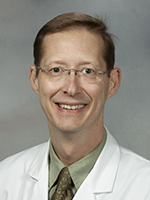#UMMCGrad17: DeRussy takes M.D./Ph.D. path to pathology

Bernadette DeRussy didn't go to medical school to become a doctor.
“I went specifically to be a pathologist,” DeRussy said.
The Diamondhead native comes from a lineage of pathologists: her grandfather and great-grandfather, their brothers and her cousin. But it goes beyond family tradition.
“Pathology encompasses nearly everything I like about science and medicine,” DeRussy said. “It involves a lot of thinking and essentially puzzle solving.”
These same qualities drew DeRussy towards biomedical research. That's where she breaks from tradition. When she graduates May 26, she will have two doctoral degrees through the University of Mississippi Medical Center's M.D./Ph.D. program, a seven-year track that trains physician-scientists.
Her mother's tales about the old family practice created her interest in pathology, but it was through undergraduate research experiences that DeRussy learned she “loved being in the lab.”
“My honors thesis advisor at Millsaps told me about the M.D./Ph.D. because of my interest in research,” she said. “I didn't know that was an option before that.”
While in UMMC's Department of Microbiology and Immunology, DeRussy wrote her dissertation on human cytomegalovirus, a member of the herpesvirus family. Most adults carry HCMV without symptoms. However, this common infection can have serious consequences for infants. Congenital HCMV is a leading cause of developmental disorders, she said, and it can also cause severe problems in immunocompromised adults, such as AIDS patients or transplant recipients.
“There are a lot of proteins on this virus, but we don't know what most of them do,” DeRussy said. She studied two, pUL93 and pUL77. According to her research, they appear to be necessary for virus maturation and DNA cleavage and packaging.
“The hope is that someday we can use this knowledge to develop antiviral drugs,” she said.
DeRussy published two first-author papers from her dissertation in the Journal of Virology and one in Scientific Reports, among the top publications in the field. However, she said one of the highlights of her Ph.D. experience was attending and presenting her work at the International Herpesvirus Workshop in Boise, Idaho. Yes, she knows that sounds strange.
“That what's fun about it!” she said. The experience also introduced her to the broader scientific community, allowing her to meet the people behind the research she read.

Dr. Ritesh Tandon, assistant professor of microbiology and immunology, said he's seen “very few students” with DeRussy's level of focus.
“She had defined agendas and finished projects as soon as possible,” said Tandon, DeRussy's Ph.D. advisor. “If a grant proposal is due in a month, she has it done in a week.”
Others have noticed her potential as well. The American Heart Association awarded DeRussy a predoctoral fellowship during her Ph.D. research. The School of Graduate Studies in the Health Sciences recognized her with the 2016 Robert A. Mahaffey Jr. Award, the school's top award for a student with exceptional research potential.
As the study and diagnosis of disease from specimens, “pathology is a very research-friendly medical specialty,” DeRussy said, in part because of the questions pathologists ask.
Pathologists are like disease-detectives in a crime drama. They get a sample from an ill or deceased person - cells, fluids, tissues or a body - and look for clues to answer the question of “whodunit?” Does the patient have a viral infection? Is their tumor malignant? What was the cause of death? By solving the crime, the perpetrator can be caught.
Solving the puzzle is an involved process, which is what DeRussy likes.
“I tried to keep an open mind and consider other specialties during medical school, but pathology was all I ever really wanted to do,” she said. “I like that there is lot of hands-on work [in pathology], like grossing specimens.”
She also like the visual aspect, using microscopes to find signs of damage and disease you can't see with the naked eye.

Dr. William Daley, professor of pathology, mentored DeRussy with interesting pathology cases as she went through the Ph.D. portion. Through their sessions sitting at the microscope, Daley found DeRussy to be an “intelligent, bright and calm” student.
“Medical school is difficult and graduate school is difficult. The idea of doing both is daunting,” he said. “She's managed both with great aplomb.”
Next, DeRussy will start a combined anatomic/clinical pathology residency at Stanford University Medical Center. She will spend the first two years training in anatomic pathology, with rotations like surgical pathology and autopsy, before moving on to clinical, which includes molecular genetics, microbiology and chemistry. Once settled in, she looks forward to learning about research opportunities.
“Stanford has a good track-record for research funding for residents,” DeRussy said. Plus, her microbiology background opens up opportunities for a variety of basic, clinical and translational research projects.
“I know Bernadette is going to be a great pathologist,” Daley said. “This type of medicine is a good fit for her.”


